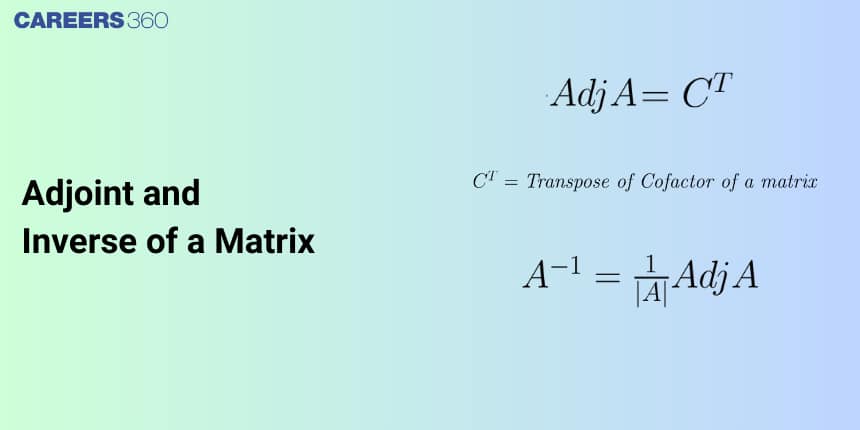Adjoint and Inverse of a Matrix
The adjoint and inverse of a matrix are two essential concepts in linear algebra. Before we learn the concept of the adjoint of a matrix, let's first understand what a matrix is. A matrix is a group of symbols organized in rows and columns to form a rectangle. The symbols may include real or complex numbers. Consequently, a m by n matrix, also known as a m x n matrix, is a system of m x n symbols arranged in a rectangular shape along m rows and n columns and bound by the brackets [ ]. The inverse of a matrix is utilized in GPS systems, where it is applied to analyze satellite signals and determine the precise location of a device. For image processing tasks like distortion correction and image scaling, matrix inverses are also crucial.
JEE Main: Study Materials | High Scoring Topics | Preparation Guide
JEE Main: Syllabus | Sample Papers | Mock Tests | PYQs
- Adjoint of a Matrix
- Properties of the adjoint of a matrix
- The inverse of a Matrix
- Solved Examples Based on Adjoint of Matrix

In this article, we will cover the concept of adjoint and inverse of matrix. This category falls under the broader category of Matrices, which is a crucial Chapter in class 11 Mathematics. It is not only essential for board exams but also for competitive exams like the Joint Entrance Examination(JEE Main) and other entrance exams such as SRMJEE, BITSAT, WBJEE, BCECE, and more. Over the last ten years of the JEE Main Exam (from 2013 to 2023), a total of 26 questions have been asked on this concept, including two in 2020, three in 2021, nine in 2022, and nine in 2023.
Adjoint of a Matrix
Adjoint of a matrix A is the transpose of the cofactor matrix of the matrix A. A Cofactor matrix of matrix A is a matrix that has the same order as that of A and has elements in place of
and let the cofactor of every element is
then Adjoint of
Properties of the adjoint of a matrix
1. If A is a square matrix of order n, then
Proof:
Let,
Since the sum of the product of elements of a row (or a column) with corresponding cofactors is equal to
If
2. If
Proof:
Taking determinants on both sides
3. If
4. If
5. If
Proof:
replace
Pre - multiplying both sides by matrix
6. If
Proof: from the previous property, we know that
Taking determinants on both sides,
(using
7. If
8. If
The inverse of a Matrix
A non-singular square matrix A is said to be invertible if there exists a non-singular square matrix B such that
AB = I = BA
and the matrix B is called the inverse of matrix A. Clearly, B should also have the same order as A.
Hence,
The formula for the inverse of
We know
Hence,
The formula for the inverse of A is
Recommended Video Based on Adjoint of Matrix:
Solved Examples Based on Adjoint of Matrix
Example 1: Let
Solution:
Hence, the required answer is
Example 2: Let
Let
If
Solution
Hence, the required answer is 221.
Example 3: Let
Hence, the required answer is 64.
Example 4: Let A be a
Solution:
As for any square matrix P of order n and a scalar k,
Given that this equals
Hence, the required answer is 4.
Example 5: Consider a
Solution:
Totel Natural number solutions of this equation
Removing cases where
Similarly 4 cases each for
Hence, the required answer is 42.
Frequently Asked Questions (FAQs)
Adjoint of a matrix A is the transpose of the cofactor matrix of the matrix A. A Cofactor matrix of matrix A is a matrix that has the same order as that of A.
Multiplication of matrix with its adjoint is commutative. Then, If A is a square matrix of order n, A(adj A) = (adj A)A
If A is a square matrix of order n and k is a scalar, then, adj(kA) = kn-1·(adj A). adj(2A) = 2(2-1). 3 = 2 . 3= 6
If A and B are square matrices of order n, then, adj (AB) = (adj B) (adj A)
A non-singular square matrix A is said to be invertible if there exists a non-singular square matrix B such that AB = I = BA and the matrix B is called the inverse of matrix A.
Also Read
15 Feb'25 10:35 AM
14 Feb'25 01:24 PM
14 Feb'25 01:19 PM
14 Feb'25 01:11 PM
14 Feb'25 01:08 PM
14 Feb'25 01:01 PM
14 Feb'25 12:51 PM
14 Feb'25 12:48 PM
23 Sep'24 07:19 PM

